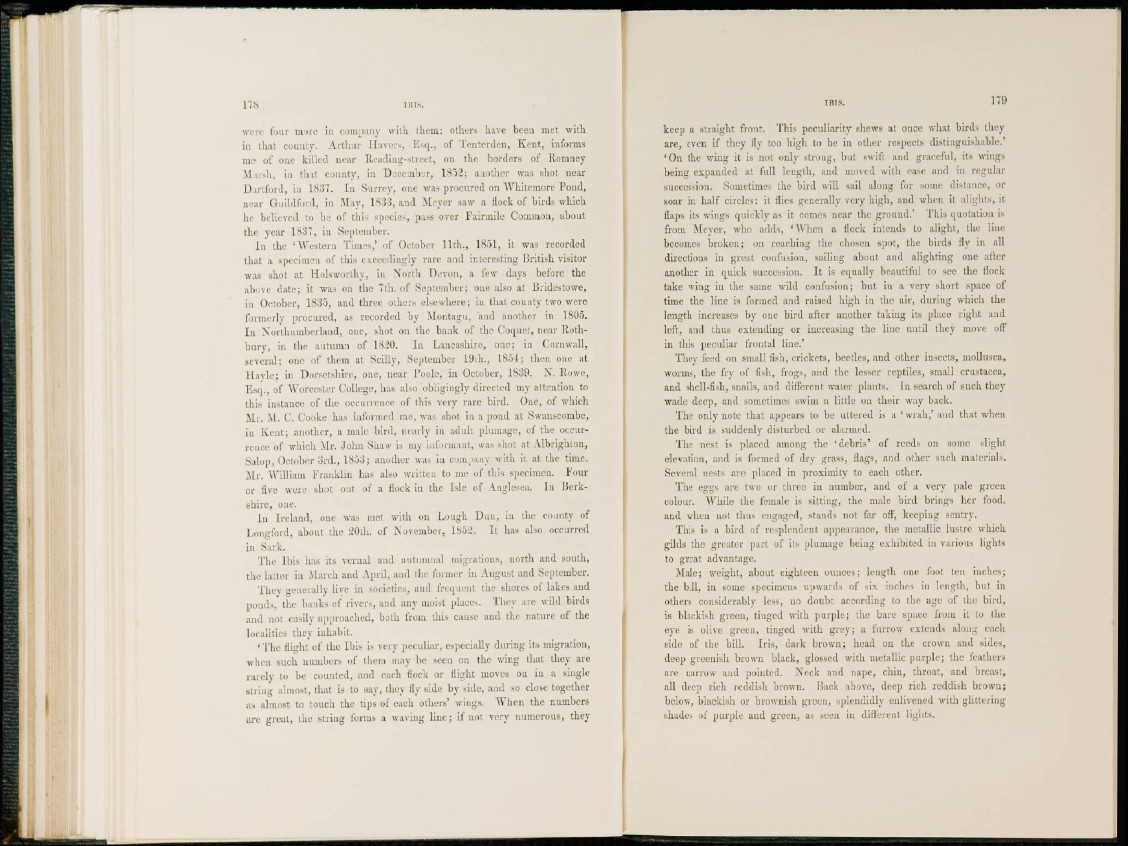
178 ] BIS
were four more in company with them: others have been met with
in that county. Arthur Havers, Esq., of Tenterden, Kent, informs
me of one killed near Reading-street, on the borders of Romney
M u s h , in that county, in December, 1852; another was shot near
Dirt ford, in 18-37. In Surrey, one was procured on Whitemore Pond,
near Guildford, in May, 1833, and Meyer saw a flock of birds which
he believed to be of this species, pass over Fairmile Common, about
the year 1837, in September.
I n the 'Western Times,' of October 11th., 1851, it was recorded
that a specimen of this exceedingly rare and interesting British visitor
was shot at HI>lsworthy, in North Devon, a few days before the
above date; it was on the 7th. of September; one also at Bridestowe,
in October, 1835, and three others elsewhere; in that county two were
formerly procured, as recorded by Montagu, and another in 1805.
I n Northumberland, one, shot on the bank of the Coquet, near Rothbury,
in the autumn of 1820. In Lancashire, one; in Cornwall,
several; one of them at Scilly, September 19ih., 1854; then one at
H a v l e ; in Dorsetshire, one, near Poole, in October, 1839. N. Rowe,
Esq., of Worcester College, has also obligingly directed my attention to
this instance of the occurrence of this very rare bird. One, of which
M I . M. C. Cooke has informed me, was shot in a pond at Swanscombc,
in Kent; another, a male bird, nearly in adult plumage, of the occurrence
of which Mr. John Shaw is my Informant, was shot at Albrighlon,
Salop, October 3rd., 1853; another was in company with it at the time.
Mr. William Franklin has also written to me of this specimen. Four
or five were shot out of a flock in the Isle of Anglesea. In Berkshire,
one.
I n Ireland, one was met with on Lough Dun, in the county of
Longford, about the 20th. of November, 1852. It has also occurred
in Sark.
The Ibis has its vernal and autumnal migrations, north and south,
the latter in .March and April, and the former in August and September.
They generaUy live in societies, and frequent the shores of lakes and
ponds, the banks of rivers, and any moist places. They are wild birds
and not easily approached, both from this cause aud the nature of the
localities they inhabit.
' T h e flight of the Ibis is very peculiar, especially during its migration,
when such numbers of them may be seen on the wing that they are
rarely to be counted, aud each flock or flight moves on in a single
string almost, that is to say, they fly side by side, and so close together
as almost to touch the tips of each others' wings. When the numbers
are great, the taring forms a waving line; if not very numerous, they
IBIS. 1 79
keep a straight front. This peculiarity shews at once what birds they
are, even if they fly too high to be in other respects distinguishable.'
' O n the wing it is not only strong, but swift and graceful, its wings
being expanded at full length, and moved with ease and in regular
succession. Sometimes the bird will sail along for some distance, or
soar in half circles: it flics generally very high, and when it alights, it.
flaps its wings quickly as it comes near the ground.' This quota!ion is
from Meyer, who adds, ' When a flock intends to alight, the line
becomes broken; on reaching the chosen spot, die birds fly in all
directions in great confusion, sailing about and alighting one after
another in quick succession. It is equally beautiful to see the flock
take wing in the same wild confusion; but in a very short space of
time the line is formed and raised high in the air, during which the
length increases by one bird after another taking its place right and
left, and thus extending or increasing the line until they move off
in this pecidiar frontal line.'
They feed on small fish, crickets, beetles, and other insects, mollusca,
worms, the fry of fish, frogs, and the lesser reptiles, small Crustacea,
and shell- f i s h , snails, and different water plants. In search of such they
wade deep, and sometimes swim a little on their way back.
The only note that appears to be uttered is a £ wrah,' and that when
the bird is suddenly disturbed or alarmed.
The nest is placed among the ' debris* of reeds on some slight
elevation, and is formed of dry grass, flags, and other such materials.
Several nests are placed in proximity to each other.
The eggs are two or three in number, and of a very pale green
colour. While the female is sitting, the male bird brings her food,
and when not thus engaged, stands not far off, keeping sentry.
This is a bird of resplendent appearance, the metallic lustre which
gilds the greater part of its plumage being exhibited in various lights
to great advantage.
Male; weight, about eighteen ounces; length one foot ten inches;
the bill, in some specimens upwards of six inches in length, but in
others considerably less, no doubt according to the age of the; bird,
is blackish green, tinged with purple; the bare space from it to the
eye is olive green, tinged with grey; a furrow extends along each
side of the bill. Iris, dark brown; head on the crown and sides,
deep greenish brown black, glossed with metallic purple; the feathers
are narrow and pointed. Neck and nape, chin, throat, and breast,
all deep rich reddish brown. Back above, deep rich reddish brown;
below, blackish or brownish green, splendidly enlivened with glittering
shades of purple aud green, as seen in different lights.